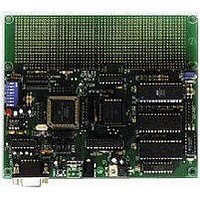CMD-711EX AXIOM, CMD-711EX Datasheet - Page 6

CMD-711EX
Manufacturer Part Number
CMD-711EX
Description
Microprocessor Development Tool
Manufacturer
AXIOM
Datasheet
1.CMD-711EX.pdf
(15 pages)
Specifications of CMD-711EX
Silicon Manufacturer
Freescale
Kit Contents
Board
Silicon Family Name
68HC11E
Silicon Core Number
MC68HC11E9FN, MC68HC11E20FN
Development Tool Type
Hardware - Eval/Demo Board
Lead Free Status / RoHS Status
Contains lead / RoHS non-compliant
4. Re-Assemble the HELLO.ASM program as described previously.
5. Select “Program” from the toolbar and when prompted for a file name, select HELLO.S19 from the examples
directory and choose External Program Memory from the options.
6. Follow the instructions on screen. When finished programming, be sure to reset the mode jumpers.
7. Cycle power or press the RESET button on the board. The program should now start automatically.
To return to development mode, repeat the above steps starting with number 5, substituting BUF34E.S19 instead of
HELLO.S19.
Programming Internal EPROM
If you wish to distribute your software on-chip (either in EPROM or OTP versions of the micro.), you can program it
into U1 using the same method described above, just select Configure and enable the ROMON bit then select
Internal Program Memory in step 5. This will put your program in the EPROM on the microcontroller. This may be
either in OTP form or UV erasable (windowed) form.
NOTE: A programming adapter can be purchased from Axiom Mfg. to provide programming for different 68HC11
package styles or for easier insertion and removal.
USING THE BUFFALO MONITOR
The debug monitor program supplied for this board is called BUFFALO (Bit User Fast Friendly Aid to Logical
Operations). This is a freeware command driven debugger originally written by Motorola that has been modified
slightly to work with this development board. This software provides an embedded means for uploading your
application software to RAM and executing it in a controlled environment using software breakpoints, trace and
memory monitoring features.
The monitor program communicates via the HC11 serial port (SCI) interface. It is executed from EEPROM (external
to the MCU). When you first receive your board, the monitor is programmed into the external EEPROM at locations
$E000 - $FFFF.
IMPORTANT: If you program external memory you will probably over-write whatever program is currently in memory
at the time, including the monitor program, and that program will no longer start on reset. To restore the Buffalo
Monitor, you must re-program the EEPROM, using the programming utility software supplied, with the file named
BUF34E.S19 which is on the software disk.
While writing your software to debug under the monitor, be aware that the monitor program itself uses internal RAM
located at $0036-$00FF and the control registers located at $1000-$103F. The monitor program also uses Output
Compare 5 (OC5) and XIRQ for the TRACE instruction, so OC5 and XIRQ should not be used in any of your routines
being traced.
OPERATING INSTRUCTIONS
To execute the monitor software (or any application running from EEPROM) the MODE switches must be in normal
run mode state, usually all OFF. If you have the serial cable connected, an open com terminal window and the
Buffalo Monitor in EEPROM, pressing the RESET button will display a message prompt as follows:
BUFFALO 3.4AX - AXIOM VERSION of MOTOROLA MONITOR / DEBUGGER
Press ENTER to continue, this will bring up a prompt, which is a > sign. You can now begin to enter commands,
upload code or view memory contents.
Type HELP and press enter to get a quick list of commands available. For complete documentation of all the
commands available with the monitor and how to use them, see the online help or the file on the disk called
buffalo.txt.
6
















